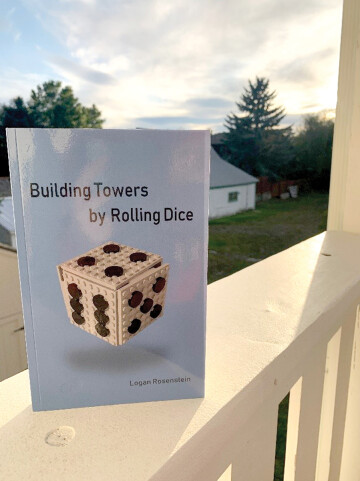Building Towers by Rolling Dice
Exploring and Understanding Mental Health with Logan Rosenstein
Building Towers by Rolling Dice tells the story of Tyler, a young man navigating the trials and tribulations of high school and early adulthood while struggling with depression and anxiety. Initially intended as a private gift for a loved one struggling with similar issues, author Logan Rosenstein has self-published and made his book available to the public. We recently sat down and talked about the writing process, mental health stigma, and how writing can force us to acknowledge and accept uncomfortable topics.
Christie Selemsky: So, tell me about your writing experience. Have you always considered yourself a writer?
Logan Rosenstein: No, that’s the weird thing. I was always really bad at writing in school. This was a gift for someone. I thought this could be a weird, quirky thing I could do. I always thought about doing a blog, ‘cuz I was working in marketing for a long time, but nothing more than a few pages. So this was one of those things like, “Could I do it?” So, I just started one day and finished it a couple months later.
CS: Wow, that’s pretty amazing that you could just jump into writing a book and finish it so quickly- a lot of people can’t
do that.
LR: Yeah it was a weird thing, ‘cuz I finished one version of it and gave it as a gift at the time, but then I gave it to my family and friends- and I have a lot of close family and friends that came from Hollywood and writing backgrounds- and they were saying “This is great, but you could look at this, or look at this side of it,” so this is essentially the second draft of it. But I still don’t consider it finished. And it’s a weird concept. I don’t consider myself a writer, and I don’t plan to have a career in it, but it’s like
“Do I plan on drafting it again?” Like, I don’t know.
CS: You mention it was a gift for someone. Tell me a little more about your inspiration for the book.
LR: A lot of people that I’ve known have had a lot of troubles. And one in particular, it got really public, and there was a huge loss of privacy. For me, it always bothered me that certain people were struggling and that they had all their dirty laundry aired. And then they had this stigma put on them that they were alone. Then when I first went to counseling and I told my friends, almost all of them said, “Oh yeah, I’ve done that.” Then you start to realize it’s a lot more widespread. I had the reputation of not having these problems, and as soon as I came out with it, the concept of the book is “Well, how are people going to handle that normal people are having these types of situations?” And so the goal was to reduce the stigma for the people I know. That whole concept of “Here’s something new about me. You’ve known me my whole life, now what?” When I wrote that first version, I got a call from my best friend that’s known me since 5th grade and said he had no idea that any of this was going on. And I had been with this guy every day of my high school years and early college. And he had no idea. There’s a lot of people who’ve had these types of experiences, but they’re presenting a version of themselves where people don’t necessarily understand what’s going on underneath the hood. Then there’s no empathy or understanding that goes on between the two. So I wrote so people can see that what’s going on underneath the hood may not match the outside, but that doesn’t mean people are broken.
CS: And what’s interesting to me about that is while you initially wrote this for someone else who was struggling with mental health issues, it sounds like it ended up being emotionally cathartic for you, too.
LR: Yeah, writing it was hard. For starters, I’m severely introverted. The concept of letting strangers read, essentially, my mental diary, is weird. That exercise was a huge hurdle. ‘Cuz you’re going along and writing, and you think it’s not a big deal, and then you realize, “Oh crap, I’m writing this for someone to read.” And you’re not only reliving things that contributed to those situations, but you’re trying to think of it in a different way to spin it to protect the people in your life and keep it fiction. But, once it was done, one of the cathartic things about it was when my friends read it, then they understood me to the point where communication was better.
CS: And I think one of the benefits of writing a fictional piece versus just making it an autobiography is getting some sort of emotional distance to the story. You can put feelings out there, but also kind of separate yourself from the writing.
LR: And there’s obviously preconceptions if you know the person. So if I were to write it from my perspective, from my exact life, people may say, “Wait, I was there, and I didn’t see it that way, so I’m not going to believe this.” Doing it from another person’s perspective made it seem like it’d be easier to digest than actively attacking someone’s understanding of me. But writing it from that perspective was a little harder actually, because I essentially had to take those components of me and put them into every single character in different ways. It’s a weird concept of I didn’t feel distance to the story personally, but I know the reader feels distance.
CS: And you talk a little bit about this on the description on the back of the book- I think mental health issues are being talked about and accepted more in society, but there’s still a lot of stigma surrounding it, especially with young men- you know,
don’t talk about your problems, put on
a happy face-
LR: Grin and bear it.
CS: Exactly. And it feels like your writing really speaks to men especially.
LR: I have noticed it is somewhat easier for women to go out and seek counseling. It’s a little more supported. And I found out when I went into counseling, that I got the most support from my female friends. It was really, really accepted. But I always found myself really embarrassed to tell my guy friends. You’re expected to be a little bit more together, and if you’re not, you just get run over. Admitting a vulnerability is a tough thing to do. There’s a fear of getting help, especially as a guy. There’s the old joke of, “Never pulling over to ask for directions.” One of the things I found out for myself is that the most struggle and the most pain I ever had was because I was afraid to ask someone for help, regardless of the situation. And mental health is the ultimate ask for help, because if you can’t ask for help, you can go down really dark roads. So I’m trying to say, it’s ok to ask for help and get a different perspective. A lot of the difficulties in male culture are about being unable to communicate problems and admitting that you don’t know something. And part of mental health is about admitting you don’t know how to fix a problem you’re experiencing. It didn’t destroy my world to ask for help. If anything, it made everything better.
CS: Absolutely. The book’s named after a game you describe in the book where Tyler and his brother build a tower of Legos based on dice rolls, seeing how tall they can make it without the tower toppling over. How is this idea significant to the rest of the book?
LR: I was trying to think of a way to say, “You don’t have control over everything that happens.” There’s that saying, “You roll the dice.” But I’ve always hated that phrase, ‘cuz it just ends with that. Because it’s like when you roll the dice, what decisions do you then make with those dice rolls? And the concept of the tower was that you would build based on whatever happens with the dice roll. You try and build the foundation, you take the lesson and experience you got from that, then add it to that foundation of how you’re going to address stuff in the future. Every time you learn something, you build up this tower, and then every once in a while it falls. You have to accept that. And that’s one of the hardest things as a guy is when you’re always trying to show this big and strong image, you don’t want to admit when it fell. So this whole thing was about, it’s ok, it’s going to fall. And when you do roll the dice again, you can know your foundation is going to be a little bit stronger.
CS: One of the aspects I really liked about this book was the strong element of humor. How do you see humorous elements contributing to the book?
LR: I think one of the parts about being really introverted is I grew up with a heavy, sarcastic sense of humor. When I was in an awkward situation, I’d add sarcasm to lighten the load. I used that myself, so if other people used it, it could make the book more digestible. Because when you talk about these types of topics, it gets really dark and really heavy, and it scares people away. If you can throw the humor in, it kind of catches people off guard a little bit. And if they’re caught off guard, they’re like “Okay, I’ll keep going.” It’s okay to have a dark sense of humor, it’s okay to be sarcastic, because at the end of the day, it means you’re digesting what’s happening. And if I let people read it that way, I’d hope people would have that reaction too. It’s okay to feel uncomfortable, so here’s a joke. Trying to lessen the load.
CS: And I think by adding in that element of sarcasm and humor into the book, you’re able to relate, but you also might be learning the lessons behind it without even knowing it.
LR: Yeah, the mix of sarcasm and analogies was kind of how I hoped I could get some of those core messages across. The problem is, when you do it that way, not everyone catches it. Then it just seems like it’s a book of analogies and jokes. I do get the comment, “Is it a self-help book?” And it’s not necessarily. If it helps you, great. If it helps you understand other people in trouble, great. But you can take it however you want to take it.
CS: Who do you see as your core audience for your writing?
LR: The book seems to be the most impactful for parents with kids that are in middle school or high school. ‘Cuz it’s not necessarily a topic kids will actively seek out. But what I’ve found is that, I have some friends and family that are child psychologists, or educators, and they’ve been saying “This is what kids should be reading in high school.” Because they don’t have the mechanisms to understand each other the way they should. So it seems like the parents are having these opinions, not the kids themselves. Which is fine with me, because at the end of the day, a lot of how kids see themselves and the environment around them comes from how they interact their parents, and how their parents interact with them. And so, having that understanding that when you’re talking with your kid, certain things may be going on in their head, then that’s fine with me.
CS: What was the most challenging aspect of writing this book?
LR: The writing itself wasn’t that hard because I wasn’t writing it knowing it would be published. It was just meant to be for friends and family. The hardest thing for me was basing the concept of something that I wrote becoming common knowledge. Because obviously, we present a version of ourselves to the public. But this had the potential to change a lot of things. As in, the people I interact with would change. That’s what I was really nervous about. But so far, reactions have been great. But leading up to September 17th, waiting for it to be released, that was the most anxiety and stress of the process.
CS: Will you write more in the future?
LR: Well, I never considered myself becoming an author. But the feedback I’ve been getting from people is that, they way that people understand the characters seems to be unique, and you can really identify with the characters. If I write something else, the character would still be that same vulnerable, identifiable type of person. The story can be totally different, but it would be more about that type of character. But I don’t know if I’ll go down that road. We’ll see what happens with this thing.
Building Towers by Rolling Dice can be found on any major bookseller website, as well as locally at Country Bookshelf. Special thanks to Logan Rosenstein for sitting down to chat.




